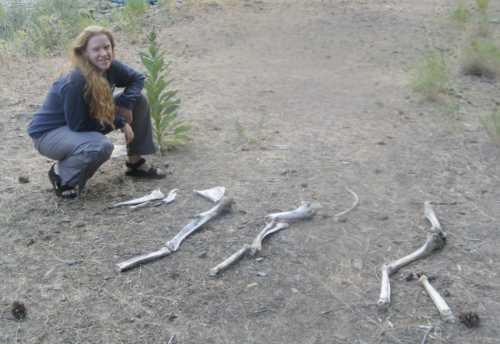While at our fifth sample site on our journey along the Grande Ronde River, we came across some interesting objects during our amphibian and reptile search. We first noticed half of a lower jaw bone which we identified as an elk, through the presence of a hole where a lower canine once appeared. When we continued up the canyon wall for our bird count, we discovered three more large bones, presumably from the same animal. Elk and other related species have several interesting morphological adaptations in their skeleton. Elk have an unguligrade posture in which they walk on the tips of their toes. Thus, elks and other ungulates have a single extended carpometacarpus for their forelimbs and tarsometatarsus in their hind limbs (whereas humans would have five separate metacarpals and metatarsals, respectively). Upon finding several of these pieces as well as two humerus and ulna bones along with a femur, rib, and scapula, we decided that the scattered animal remnants were worth further investigation.
Our initial questions pertained to the elk’s probable cause of death. All of the bones showed minimal wear and tear with no teeth marks. And many of the bones were scattered quite a distance away from each other. From our speculations, we determined that the elk’s likely cause of death was not due to predation, for the bones would have been much more cracked, damaged, and shown signs of biting if that were the case. We did not find a whole skeleton, however, so there may have been some chewed bones that we missed. The teeth on the lower mandible were all present, indicating that this individual was mature, and there was evidence of significant wear of these teeth which implied to us that this individual may have been older and more prone to mortality. Considering this evidence, we determined that the elk most likely died of natural causes and was then scavenged by other animals.
Congruent with our theory of a natural death, the elk could have been migrating along the Grande Ronde River when it died. Elks venture down the canyon walls in search of warmer areas and food for the winter and then ascend once again in the spring and these bones may have been remnants from last winter. These bones were clean with minimal flesh present which makes sense if they had been exposed to the elements since last winter. There would have been plenty of time for them to be picked clean by natural weathering processes and by animals. This also supports our theory of a natural death, in that conditions are often harsh during the winter due to cold weather and scarcity of food, which ultimately results in higher rates of mortality.
We transported the bones and reconstructed the above skeleton at our campsite on the bank opposite to the Grossman Creek confluence with the Grande Ronde River (river mile 63). Reconstructing the skeleton gave us both a chance to put what we had learned in anatomy and mammology classes into practice, and even try our hand at forensic science! It proved to be a bit harder than we first envisioned, but in the end I think we figured it out. What do you think?

